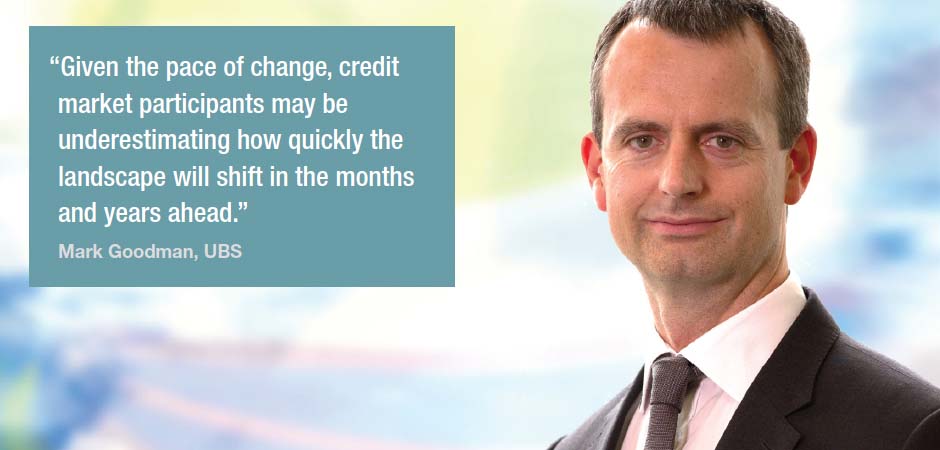
By Mark Goodman, Managing Director, Global Head of Electronic Execution – FX, Rates, Credit & Futures at UBS Investment Bank.
Our age’s fascination with technology is sometimes puzzling. On one hand, we hail the benefits of “disruptive” innovation. On the other, we routinely underestimate the depth and breadth of change that innovation will bring. Often this is due to our focus on technology as a driver of efficiency but the outcome is generally much more significant.
An example is the music industry’s transformation to a business model increasingly built around streaming. At first, few in the industry appreciated the degree of change that streaming services would deliver. On that point, the history of streaming services – called the “big juke box in the sky” by one music executive – offers an object lesson for credit markets in how thoroughly technology’s network effects can upend expectations of incremental change.
The streaming revolution’s roots go back 20 years, when the arrival of Napster and similar services threatened the music industry’s business model. The industry quickly declared war on the “piracy” of illegal downloads and unauthorised file sharing. Regiments of corporate lawyers were dispatched to the courtroom to turn back the tide, winning some significant battles.
But a few music industry strategists, aware that the traditional business model was under threat, quietly began working behind the scenes on new ways to give consumers digital access. Streaming offered an alternative distribution and pricing model, combining subscriptions and the ability to access individual songs in a vast offering. Adding to the appeal of streaming for record companies was their reduced burden of manufacturing millions of CDs, holding significant physical inventories, and transporting their products on trucks to the retailers. In short, they saw the technology as a way to improve efficiencies.
Initially this outcome was as expected. Not surprisingly, streaming initially depressed revenues and drove consolidation in some parts of the industry over the years, a pattern often seen in transitional periods of disruption. Only a few years ago, record company executives were still worrying that industry revenues were in a permanent funk.
Then trends began to reverse in recent years as the subscriber base of digital music platforms such as Spotify and Apple Music reached what might be regarded in retrospect as a tipping point. Streaming services now reach over 100 million music fans worldwide.1
This year, streaming is on track to generate the largest source of revenue for the global music industry, according to PwC, eclipsing sales from downloads, CDs and vinyl records. The consulting firm estimates that streaming revenues will grow 37%, to $9.1bn.2
Music executives now talk of how streaming “democratised” access to music, making it easier and less expensive. “The value of reliability, convenience and accessibility to an enormous catalogue of songs for a small cost now trumps illegally downloading a song free,” says Paul Smernicki, former head of digital at Universal Music. “I thought the days of the music industry talking about anything in terms of millions were gone, but now we are looking at billions of streams on an almost daily basis.”3
However, more interesting than the efficiency gains were the secondary impacts. The streaming revolution has had a number of unexpected effects on consumer behaviour. With the rise of streaming music videos, many in the industry expected concert attendance to fall off. The opposite happened.
Instead, the growing access to streaming music and videos fuelled demand among younger audiences for live, shared experiences at concerts. Revenue from live concert tickets in the US has more than doubled in the decade to 2015, to $6.9bn.4 Not widely foreseen was how this enthusiasm for sharing experiences would create secondary effects, such as driving global participation on platforms such as Instagram and Facebook.
These mutually reinforcing demands for streaming music and live, shared experience has record industry and event companies rethinking how to engage customers. Here’s Brooke Kain, chief digital officer of AEG Live, describing her vision of how mobile and bots might be used to engage customers:
“Where I’d envision it going is that a consumer would barely even have to open their app or even open their phone… They use their phone to purchase things, the ticket’s there, it’s scanned, we know who you are, we receive beacon data, and we can offer you a personalised [food and beverage] experience based on the fact that you just walked in the venue. That kind of seamless, transparent transaction I think is somewhere we could be moving toward.”5
Followers of the growth trends in electronic credit trading will perceive a few parallels with the music industry’s experiences. That’s because electronic markets tend to go through broadly similar stages of development. The first stages involve automating existing forms of transactions. In this stage, the benefits are mostly seen as improvements in efficiency. Transactions can be processed more quickly and efficiently, with fewer errors and automated record keeping.
As adoption grows and networks achieve greater scale, second- and third-order benefits begin to kick in. That’s when real change begins.
Customers find they can more easily “shop” for transactions and choice is vastly expanded. New protocols and products are introduced specifically to take advantage of the network benefits. Market participants have the ability to express their views on the network, expanding engagement with existing users and attracting new participants. Legal and regulatory structures, along with new industry standards, emerge that hasten adoption, leading to a still larger network and higher transaction volume.
The development of UBS Bond Port is a case study in how network benefits tend to change behaviour and boost network growth. Bond Port was initially created to improve the ability of UBS investment bank’s trading desk to interact with UBS wealth managers on an electronic trading platform. The platform handled a high volume of comparatively small transactions.
As volume grew, the platform drew the interest of other clients who were interested in interacting in a similar way. Typically, these clients were price takers, but soon some saw opportunities to make prices as well, becoming liquidity providers. In effect, they identified situations in which they could express their view on the value of a particular bond.
The liquidity on the platform also attracted the attention of a set of clients who were active in the electronic markets for listed derivatives and other asset categories, but typically were not involved in credit trading. With Bond Port, they found they could apply their electronic strategies in trading on the platform, adding to the available liquidity. In this way, Bond Port has been instrumental in bringing new participants to the credit market and enlarging the pool of liquidity.
Bond Port exhibits many of the features driving growth in electronic credit trading. These features are among the reasons that we have seen the share of electronic trading increase to an estimated 25% of investment grade bond transactions globally.6
Other factors include regulation such as the introduction of MiFID II reporting requirements. Electronic trading makes it much easier to meet these trading reporting obligations. Another driver can be found in product trends, such as the growth of ETFs, whose operations depend on electronic liquidity. The explosive growth in fixed-income ETFs should perhaps be counted as one of the unforeseen collateral effects of the growth in electronic trading.
Less noted – but of significant importance – is generational change. Entering the market daily is a cohort of young traders who have grown up in the electronic trading environment, familiar with its strategies and toolkit.
Given the pace of change, credit market participants – like those music executives in the early period of digital distribution – may be underestimating how quickly the landscape will shift in the months and years ahead. Streaming’s history shows that change can come on a market faster and more extensively than many expect.
Few observers would risk extrapolating current trends in electronic trading at a time when the credit markets have seen a long period of relative calm and central banks looks poised to pursue tighter payment. There are many “known unknowns.” Will volatility return, spurring higher trading volumes? Will regulations continue to evolve in ways that support the electronic market?
But there are “known knowns” as well. First, as electronic trading takes a greater share of market volume, success will depend on new sets of capabilities and skills. For example, the quality of an investment bank’s global network will come to count as much as the soundness of its balance sheet.
Second, clients will likely feel more competitive and regulatory impetus to step up involvement in electronic markets. As a result, they will gravitate to banks with a record of expertise in navigating these disparate, growing pools of electronic liquidity.
A mastery of electronic trading strategies will prove fundamental to competing in the new environment. If a bank can deliver on these strengths, it’s far more likely to find a seat when the music stops.
Footnotes:
1. Financial Times, “How Streaming Saved the Music Industry,” January 16, 2017
2. Financial Times, “Streaming Revenue to Surpass Physical Music Sales This Year,” June 6, 2017
3. Variety: “Live Nation Leads the Charge in Concert Business’ Booming Revenue,” February 7, 2017
4. Economist: “Nothing can beat a live event,” February 9, 2017
5. Variety: “Live Nation Leads the Charge in Concert Business’ Booming Revenue,” February 7, 2017
6. Economist: “Digitisation shakes up corporate-bond markets,” April 22, 2017
Disclaimer:
The above should not be construed as a solicitation or an offer to buy or sell any financial instrument. UBS Bond Port is not available in all jurisdictions.
©Markets Media Europe 2025












